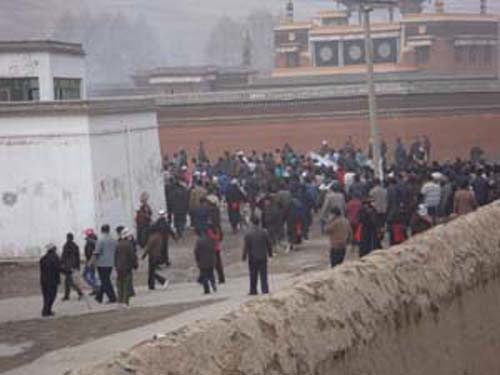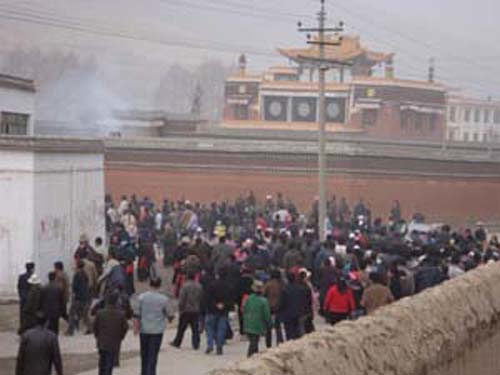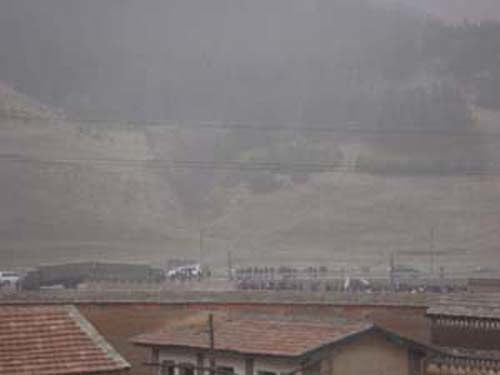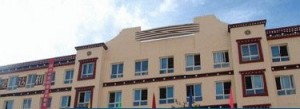


All photos: VOA Tibetan language TV
New images of a protest by Tibetan schoolchildren in Labrang (Chinese: Xiahe) on April 24 have been obtained from Tibet.
The images confirm that several hundred students from Labrang Tibetan Middle School, including several children who appear to be as young as ten or 11, were involved in the protest against continued vilification by the authorities of the Dalai Lama. One image shows a group of young girls, who appear to be aged around 12, many in traditional Tibetan dress, leading a group of protestors. The incident occurred in Labrang (Sangchu) county, Kanlho (Chinese: Gannan) Tibetan autonomous prefecture, Gansu province, the Tibetan area of Amdo. Other images depict children carrying what appear to be home made white banners. Adults or older students can also be seen, and monks (probably from Labrang monastery) are visible in the distance, although they do not appear to be part of the protest.
The protests depict the moments before armed police moved into apprehend the students. In a further image, army trucks can be seen in the background. The number of demonstrators and bold nature of the protest clearly took the authorities by surprise despite the tight security in the area. While the students detained are now believed to have been released, some after being beaten, local Tibetans fear further retaliation by the authorities.
Some images have been withheld as they reveal identities of individual Tibetans. Since the current wave of protests began in Tibet on March 10, 2008, the authorities have adopted increasingly systematic measures to block information flow from Tibet. A few months after the protests began last year, the authorities conveyed warnings of penalties for ‘spreading rumors’, presaging a new wave of detentions and signaling a more rigorous and hard-line approach to Beijing’s cover-up of the crackdown in Tibetan areas. These images of the protest clearly involved significant risk.
All images were obtained by the Tibetan service of Voice of America.
Tibetan teenagers from Labrang (Chinese: Xiahe) Tibetan Middle School in the Tibetan area of Amdo made a bold protest on April 24 against continued vilification of the Dalai Lama and an ‘anti-separatism’ campaign in schools in the area, according to several Tibetan sources. While the students detained are now believed to have been released, some after being beaten, local Tibetans fear further retaliation by the authorities. Tibetan areas including Labrang have been tense since protests began to spread across Tibet from March 10, 2008.
The protest occurred in the town of Labrang, Sangchu (Chinese: Xiahe) county, Kanlho (Chinese: Gannan) Tibetan Autonomous Prefecture, Gansu province, the Tibetan area of Amdo. Tibetan students reportedly took to the streets near the school at around 8:00 a.m. on Friday, April 24. Many were calling for freedom and democracy, and for the return of the Dalai Lama to Tibet. Some were protesting about the rise in the number of Chinese students in college level institutes, displacing Tibetans.
They were immediately surrounded by armed police who stopped the protest. One Tibetan eyewitness told ICT: “Around 300 soldiers and police arrived immediately at the scene. Older Tibetans were begging the soldiers not to harm the students and to let them go back into the schoolyard. The school was then surrounded by armed soldiers.”

Sangchu Tibetan Middle School in the Tibetan area of Amdo, where students held a peaceful protest on April 24, 2009 calling for freedom, democracy and the return of the Dalai Lama to Tibet.
A Tibetan source with contacts in the area said: “The main reason for the students’ protest is that the local authorities are implementing a campaign of patriotic education and ‘anti-separatism’ in schools, which is strongly focused on denouncing the Dalai Lama. At the same time, many articles vilifying the Dalai Lama have been published in newspapers in the Tibetan language.”
According to a posting on a Chinese-language blog today: “As well as protesting about the article critical of His Holiness the Dalai Lama, students were also calling on the authorities to stop the phenomenon of ‘University Entrance Exam Refugees’ [1] where the university entrance exam quota for Tibetan students is used by students coming in from elsewhere.”
The same Tibetan source said: “What was interesting was that at the time, relevant officials from Kanlho prefecture were on their to Lanzhou to pick up an award they’d won for outstanding [political] ‘stability’ work, but this incident happened while they were on the road there and so cursing their luck, they had to head back!”
Students detained during the protest are now believed to have been released and the school, which has several hundred pupils, partially re-opened. However, there are indications that teachers are under suspicion and a continuing investigation may lead to new detentions. According to another report, the authorities have taken a list of students, which includes the names of those believed to have taken part in the protest, from the school. The same source said that officials sent to the school from the Kanlho prefectural government offices stressed that there was a need to educate the Tibetan students not to carry out “separatist” activities. “There is now an increasing military presence on the streets of Labrang, with local people saying there is a curfew in place,” the source said.
According to two Tibetan sources, a further protest by students from Sangchu County Tibetan Elementary School occurred in the past few days, although the date could not be confirmed. A report by a Tibetan on a Chinese language blog said that as a result of both protests officials strengthened control over all schools and students in Gannan prefecture, and teachers from Tsoe (Chinese: Hezuo) Vocational School cancelled leave for the May vacations.
Labrang monastery, which is near the school, was the site of demonstrations against the Chinese authorities on March 15-16, 2008. Those protests were a major indication that demonstrations were spreading across Tibetan areas of the People’s Republic of China and were not just isolated in the TAR.
Labrang monk detained
There are fears for the safety of a Labrang monk, whose whereabouts remain unknown following his detention on March 18, 2009. The monk, who is known as Tsaye Godrop-shi (Tsaye is the name of a township in Sangchu county) was detained at a police checkpoint when traveling out of Labrang by bus. He is believed to have been involved in an emotional protest during the visit of a group of foreign journalists to Labrang monastery on a rare Chinese government-organized trip last April. (ICT report, Labrang monks stage protest during official media tour – April 9, 2008).
According to the Tibetan Center for Human Rights and Democracy in India, two other Labrang monks, Thabkhey and Tsundue, are also reported to be missing.
News of detentions and disappearances of Tibetans is still reaching the outside world almost daily one year on from the beginning of the protests that have swept across Tibet, and which were met by a violent crackdown. Some have been killed in custody after torture. Others are still being detained without charge and without access to legal counsel.
[1] A literal translation. This refers to a process by which people use faked ID to show they are Tibetan and therefore sit the university entrance exam, or sit the exam because they’ve moved into the area as the children of government workers. The exams for Tibetans are also supposed to be slightly easier because of language considerations — another reason why Chinese students try and sit them if they can.

